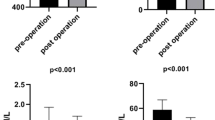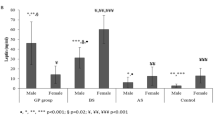Abstract
Background
The prevalence of morbid obesity has seen an increase in developed countries over recent years. Bariatric surgery is almost the only effective strategy for treating super morbidly obese patients. The objective of the study was to evaluate the effects of bariatric surgery on the evolution of the main variables related to diabetes and obesity, especially insulin resistance, parameters of oxidative stress, and inflammatory markers in the early stage after surgery.
Methods
The study was undertaken in 17 morbidly obese persons who were scheduled for biliopancreatic diversion of Scopinaro. Measurements were made before surgery and 15, 30, 45, and 90 days after surgery.
Results
We found that significant metabolic changes occurred during the first 90 days after bariatric surgery. The most significant decrease in insulin resistance occurred 15 days after the operation. At this point, the lipid profile and inflammatory and oxidative stress parameters had not improved. One month after surgery, insulin resistance had a parallel evolution to weight and the molecules directly associated with hypertrophic adipose tissue.
Conclusions
We suggest that there are two mechanisms that contribute to the improvement in insulin resistance after biliopancreatic diversion: on the one hand, a short-term effect related to gastric bypass, and on the other hand, a long-term effect from decreased fat mass and resulting changes in the release of molecules directly associated with hypertrophic adipose tissue.


Similar content being viewed by others
References
Buchwald H, Avidor Y, Braunwald E, et al. Bariatric surgery: a systematic review and meta-analysis. JAMA. 2004;292:1724–37.
Sjostrom L, Lindroos AK, Peltonen M, et al. Lifestyle, diabetes, and cardiovascular risk factors 10 years after bariatric surgery. N Engl J Med. 2004;351:2683–93.
Schauer PR, Burguera B, Ikramuddin S. Effect of laparoscopic Roux-en Y gastric bypass on type 2 diabetes mellitus. Ann Surg. 2003;238:467–84.
Garrido-Sánchez L, García-Almeida JM, García-Serrano S, et al. Improved carbohydrate metabolism after bariatric surgery raises antioxidized LDL antibody levels in morbidly obese patients. Diabetes Care. 2008;31:2258–64.
García-Fuentes E, García-Almeida JM, García-Arnés J, et al. Morbidly obese individuals with impaired fasting glucose have a specific pattern of insulin secretion and sensitivity: effect of weight loss after bariatric surgery. Obes Surg. 2006;16:1179–88.
Cummings DE, Overduin J, Foster-Schubert KE. Gastric bypass for obesity: mechanisms of weight loss and diabetes resolution. J Clin Endocrinol Metab. 2004;89:2608–15.
Rubino F, Gagner M. Potential of surgery for curing type 2 diabetes mellitus. Ann Surg. 2002;236:554–59.
Mingrone G, DeGaetano A, Greco AV, et al. Reversibility of insulin resistance in obese diabetic patients: role of plasma lipids. Diabetologia. 1997;40:599–605.
Melissas J, Malliaraki N, Papadakis JA, et al. Plasma antioxidant capacity in morbidly obese patients before and after weight loss. Obes Surg. 2006;16:314–20.
Furukawa S, Fujita T, Shimabukuro M, et al. Increased oxidative stress in obesity and its impact on metabolic syndrome. J Clin Invest. 2004;114:1752–61.
Matthews DR, Hosker JP, Rudenski AS, et al. Homeostasis model assessment: insulin resistance and beta-cell function from fasting plasma glucose and insulin concentrations in man. Diabetologia. 1985;28:412–19.
Rajneesh CP, Manimaran A, Sasikala KR, et al. Lipid peroxidation and antioxidant status in patients with breast cancer. Singapore Med J. 2008;49:640–3.
Cardona F, Túnez I, Tasset I, et al. Fat overload aggravates oxidative stress in patients with the metabolic syndrome. Eur J Clin Invest. 2008;38:510–5.
Husain K. Interaction of exercise training and chronic NOS inhibition on blood pressure, heart rate, NO and antioxidants in plasma of rats. Pathophysiology. 2003;10:47–56.
Barceló A, Barbé F, de la Peña M, et al. Antioxidant status in patients with sleep apnoea and impact of continuous positive airway pressure treatment. Eur Respir J. 2006;27:756–60.
Barb D, Pazaitou-Panayiotou K, Mantzoros CS. Adiponectin: a link between obesity and cancer. Expert Opin Investig Drugs. 2006;15:917–31.
Mari A, Manco M, Guidone C, et al. Restoration of normal glucose tolerance in severely obese patients after biliopancreatic diversion: role of insulin sensitivity and beta cell function. Diabetologia. 2006;49:2136–43.
Rubino F, Marescaux J. Effect of duodenal-jejunal exclusion in a non-obese animal model of type 2 diabetes: a new perspective for an old disease. Ann Surg. 2004;239:1–11.
Rubino F, Forgione A, Cummings DE, et al. The mechanism of diabetes control after gastrointestinal bypass surgery reveals a role of the proximal small intestine in the pathophysiology of type 2 diabetes. Ann Surg. 2006;244:741–49.
Wellen KE, Hotamisligil GS. Inflammation, stress, and diabetes. J Clin Invest. 2005;115:1111–9.
Dandona P, Weinstock R, Thusu K, et al. Tumor necrosis factor-alpha in sera of obese patients: fall with weight loss. J Clin Endocrinol Metab. 1998;83:2907–10.
Vázquez LA, Pazos F, Berrazueta JR, et al. Effects of changes in body weight and insulin resistance on inflammation and endothelial function in morbid obesity after bariatric surgery. J Clin Endocrinol Metab. 2005;90:316–22.
Tinahones FJ, Murri-Pierri M, Garrido-Sánchez L, et al. Oxidative stress in severely obese persons is greater in those with insulin resistance. Obesity. 2009;17:240–6.
Garcia-Fuentes E, Murri M, Garrido-Sanchez L, et al. PPARγ expression after a high-fat meal is associated with plasma superoxide dismutase activity in morbidly obese persons. Obesity 2009. doi:10.1038/oby.2009.314.
Cardona F, Tunez I, Tasset I, et al. Similar increase in oxidative stress after fat overload in persons with baseline hypertriglyceridemia with or without the metabolic syndrome. Clin Biochem. 2008;41:701–5.
Fujita K, Nishizawa H, Funahashi T, et al. Systemic oxidative stress is associated with visceral fat accumulation and the metabolic syndrome. Circ J. 2006;70:1437–42.
Sledzinski T, Goyke E, Smolenski RT, et al. Decrease in serum protein carbonyl groups concentration and maintained hyperhomocysteinemia in patients undergoing bariatric surgery. Obes Surg. 2009;19:321–6.
Gletsu-Miller N, Hansen JM, Jones DP, et al. Loss of total and visceral adipose tissue mass predicts decreases in oxidative stress after weight-loss surgery. Obesity. 2009;17:439–46.
Acknowledgments
This work was supported in part by a grant from the Instituto de Salud Carlos III (CP04/00133) and Servicio Andaluz de Salud (0438/2006). CIBER Fisiopatología de la Obesidad y Nutrición (CB06/03) is an ISCIII project. Murri is recipient of a predoctoral grant of Investigator Personal Formation (BES-2007-16594) from the Spanish Ministry of Education and Science. The authors thank Carlos Clue and Ana Bueno. The authors also thank Ian Johnstone for the English language version of the text.
The authors declare no conflicts of interest.
Author information
Authors and Affiliations
Corresponding author
Additional information
Murri M. and Garcia Fuentes E. contributed equally to this work.
Rights and permissions
About this article
Cite this article
Murri, M., García-Fuentes, E., García-Almeida, J.M. et al. Changes in Oxidative Stress and Insulin Resistance in Morbidly Obese Patients After Bariatric Surgery. OBES SURG 20, 363–368 (2010). https://doi.org/10.1007/s11695-009-0021-6
Received:
Accepted:
Published:
Issue Date:
DOI: https://doi.org/10.1007/s11695-009-0021-6




